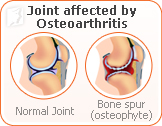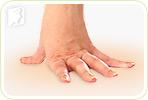
Many women report suffering from joint pain during menopause. This can be a disruptive symptom, altering what you feel you can and can't do physically. Luckily, there are plenty of treatments available for alleviating the symptoms of joint pain.
Why Do I Suffer from Joint Pain during Menopause?
Osteoarthritis is an inflammation of the joints that causes pain. However, the predominant reason women suffer from joint pain during menopause - which occurs at age 51 on average - is due to falling levels of estrogen in the body. The tissues surrounding the joints have estrogen receptors, so when there is a shortage of this hormone, joints may become painful. Aging is another compounding factor in the experience of joint pain.
How Can I Deal with Joint Pain during Menopause?
There is a variety of ways to deal with the joint pain during menopause. The most common general treatment used for menopause symptoms is hormone replacement therapy (HRT). This is where synthetic estrogen is used to supplement the diminished levels in the body. Unfortunately, however, HRT has produced mixed results in treating joint pain specifically.

More effective options for managing joint pain during menopause include:
- Weight loss. Losing weight puts less pressure on the joints and can be achieved through a healthy diet and regular exercise.
- Mechanical aids. Depending on which joints are painful, special footwear, canes, or splints - for example - can make everyday activities more comfortable.
- Nerve stimulation. This treatment can be used to lower the perception of pain by numbing nerve endings with controlled electrical pulses.
- Painkillers. Sometimes, analgesics like ibuprofen or paracetamol are necessary if moving around becomes too painful.
- Physical therapy. A professionally-trained therapist administers several techniques in order to rehabilitate the joints and muscles as well as increase mobility. One example is manual therapy, which can help decrease stiffness in the joint area.
- Hot and cold compresses. Placing alternating hot and cold packs on painful joints can help reduce pain.
- Other medications. A physician may prescribe corticosteroid injections or selective estrogen receptor modulators (SERMs) to treat osteoarthritis.
In addition to these management methods, there is also a range of plant-based therapies, such as capsaicin cream, that are analgesic, anti-inflammatory, or hormone-balancing. These may be suitable for some women, especially if combined with a healthy diet and aquatic exercise routine to alleviate symptoms naturally.
Sources
- National Health Service UK. (2015). Osteoarthritis. Retrieved October 21, 2015, from http://www.nhs.uk/Conditions/Osteoarthritis/Pages/treatment.aspx
- National Library of Medicine. (n.d.). Osteoarthritis (OA). Retrieved October 21, 2015, from http://www.ncbi.nlm.nih.gov/pubmedhealth/PMHT0024679/
- Roman-Blas, J.A. et al. (2009). Osteoarthritis associated with estrogen deficiency. Arthritis Research & Therapy, 11(5), 241. doi: 10.1186/ar2791


